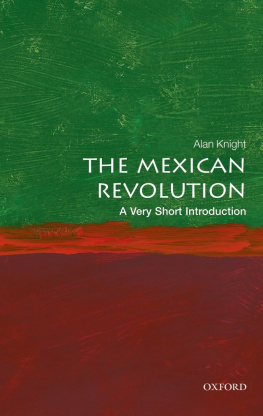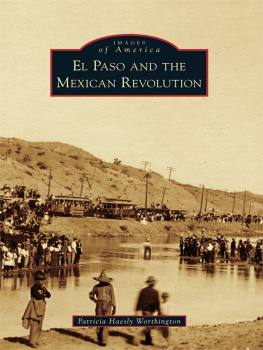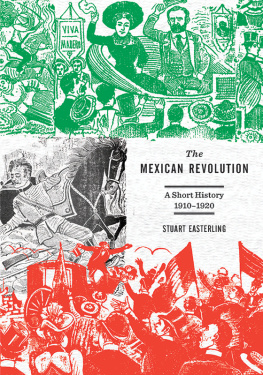THE MEXICAN REVOLUTION
NUMBER FORTY-FOUR
Walter Prescott Webb Memorial Lectures
The Mexican Revolution
CONFLICT AND CONSOLIDATION, 19101940
Edited by Douglas W. Richmond & Sam W. Haynes
Introduction by John Mason Hart
Contributors:
Nicholas Villanueva Jr.
Don M. Coerver
Miguel ngel Gonzlez-Quiroga
Linda B. Hall
Francisco E. Balderrama
Jrgen Buchenau
Stephen E. Lewis
Carlos Martnez Assad
Thomas Benjamin
Published for the University of Texas at Arlington
by Texas A&M University Press
College Station
Copyright 2013 by the University of Texas at Arlington
Manufactured in the United States of America
All rights reserved
First edition
This paper meets the requirements of ANSI/NISO Z39.481992 (Permanence of Paper).
Binding materials have been chosen for durability.

LIBRARY OF CONGRESS CATALOGING-IN-PUBLICATION DATA
The Mexican Revolution : conflict and consolidation, 19101940 / edited by Douglas W. Richmond and Sam W. Haynes; introduction by John Mason Hart; contributors: Nicholas Villanueva Jr.... [et al.].1st ed.
p.cm.(Walter Prescott Webb memorial lectures; 44)
Includes index.
ISBN-13: 978-1-60344-816-1 (cloth : alk. paper)
ISBN-10: 1-60344-816-0 (cloth : alk. paper)
ISBN-13: 978-1-60344-955-7 (ebook-c)
ISBN-10: 1-60344-955-8 (ebook-c)
1. MexicoHistoryRevolution, 19101920Influence. 2. MexicoHistoryRevolution, 19101920Political aspects. 3. MexicoHistoryRevolution, 19101920 Social aspects. 4. Mexican-American Border RegionHistory20th century. 5. Mexican-American Border RegionEthnic relationsPolitical a spectsHistory20th century. 6. NationalismMexicoHistory20th century. 7. MexicoHistory19101946. 8. TexasHistory18461950. I. Richmond, Douglas W., 1946- II. Haynes, Sam W. (Sam Walter), 1956- III. Villanueva, Nicholas. IV. Series: Walter Prescott Webb memorial lectures; 44.
F1234.M584 2013
972.08'16dc23
2012029169
Contents
John Mason Hart
Nicholas Villanueva Jr.
Don M. Coerver
Miguel ngel Gonzlez-Quiroga
Linda B. Hall
Francisco E. Balderrama
Jrgen Buchenau
Stephen E. Lewis
Carlos Martnez Assad
Thomas Benjamin
Preface
The Mexican Revolution is one of the seminal chapters in the history of Mexico. More than any other single event, the revolution was responsible for creating the modern Mexican nation-state by contributing to a greater degree of democratization, land reform, anticlericalism, and other far-reaching changes in Mexican society. In addition, the civil war, which began in 1910 and lasted more than a decade, had a profound impact on formal and informal relations between the United States and Mexico. Resulting in the flight of hundreds of thousands of refugees, the rebellion prompted the first major northern migration of Mexican citizens. In so doing, it permanently changed the demographics of the American Southwest, energizing and shaping Latino culture in the United States.
In 2008, history professor Douglas W. Richmond of the University of Texas at Arlington conceived of the idea of making the Mexican Revolution the focus of the 2010 Walter Prescott Webb Memorial Lectures, held annually by his department. Richard Francaviglia, then serving as director of the Center for Greater Southwestern Studies at UT Arlington, also began planning a series of events to commemorate the centennial of the revolution. Although Dr. Francaviglia retired the following year, work on the program continued under new director Sam W. Haynes. In its final form, the program consisted of a workshop on the Mexican Revolution for secondary-school teachers, a major photographic exhibit on the events of 19101921, and a two-day series of lectures featuring scholars from the United States and Mexico. Cosponsored by the UT Arlington history department and the Center for Greater Southwestern Studies, the chapters in this volume were presentations made on March 1011 as part of the 45th annual Walter Prescott Webb Memorial Lectures.
The historians featured in this anthology have written and researched extensively on twentieth-century Mexico. The introduction to the volume was written by John Mason Hart, the John and Rebecca Moores Professor of History at the University of Houston, widely regarded as one of the foremost authorities on the revolutionary period. In the first chapter, Nicholas Villanueva Jr., winner of the 2010 Webb-Smith Essay Competition, held in conjunction with the Webb Lectures, examines the case of Len Martnez, an El Paso youth who was executed for the murder of an Anglo woman, thereby raising questions about the fate of ethnic Mexicans living in Texas during the early years of the Mexican Revolution. Don Coerver of Texas Christian University discusses how US and Mexican officials along the border sought to deal with the outbreak of violence after 1910 and the extent to which they were successful in coordinating their efforts. Well-known Monterrey historian Miguel ngel Gonzlez-Quiroga examines the role of Monterrey during the conflict, emphasizing that many of its citizens preferred the goals of economic development and increased commercial relations with the United States to the goals of the revolution. Linda B. Hall of the University of New Mexico discusses the US governments response to the arrival of Mexican immigrants and its prosecution of those who were suspected of criminal activity. Francisco Balderrama, California State University at Los Angeles, explains how Mexican immigrants became a convenient scapegoat for communities in the Southwest, such as Los Angeles, which were suffering economic hardship during the Depression. This led to widespread repatriation drives, with the result that one million Mexicans were illegally returned to Mexico. Professor Jrgen Buchenau of the University of North Carolina at Charlotte analyzes several significant leaders from the state of Sonora who controlled Mexico from 1920 to 1934 by means of astute political maneuvering and decisive military campaigns while championing the working class, anticlericalism, and education. Stephen Lewis of California State University at Chico examines the marginal, ethnically diverse state of Chiapas, which fiercely resisted the land, labor, and educational reforms commonly associated with the revolution. The violence that broke out in Chiapas at the end of the twentieth century may be attributed at least in part, Lewis maintains, to the compromised nature of the revolutions reforms. Dr. Carlos Martnez Assad of the Universidad Nacional Autnoma de Mxico examines the postrevolutionary return to centralism in the 1920s and 1930s, when President Lzaro Crdenas initiated the process of limiting the power of regional leaders by consolidating the authority of the national governments political party, the Partido de la Revolucin Mexicana. The final chapter in this anthology is by Thomas Benjamin, Central Michigan University, who presented the Webb Lectures keynote address, Whither the Mexican Revolution? The Revolution as Legacy and Project. In this fitting postscript, Benjamin examines the memory and the legacy of the revolution and considers how they can be used by those seeking a progressive transformation of Mexico in the twenty-first century.
The photographs in this volume have been selected from three separate collections, all of which were exhibited on campus during the Mexican Revolution centennial program at the Center for Greater Southwestern Studies. In the spring of 2010 the UT Arlington Library was the venue for Mexico: The Revolution and Beyond, a touring exhibit of more than 90 images from the Archivo Casasola, one of the worlds first news-photography agencies, on loan from the National Institute of Anthropology and History (INAH) in Mexico City. The Center for Greater Southwestern Studies also secured La Tierra y su Gente: The Rio Grande Photographs of Robert Runyon, a collection of 32 images by Brownsville commercial photographer Robert Runyon from the archives of the Dolph Briscoe Center for American History, UT Austin. To complement these two exhibits, the Center for Greater Southwestern Studies, working with the staff of the Central Librarys Special Collections, produced an exhibit of its own, Images of Conflict, 19101921, a selection of 40 images of various aspects of the revolution, from the Porfiriato to the Obregn years. Together, these three exhibitstotaling 162 imagesprovided a unique and compelling visual chronicle of life in Mexico and along its border with the United States in the early decades of the twentieth century.
Next page





